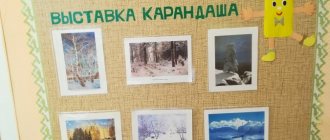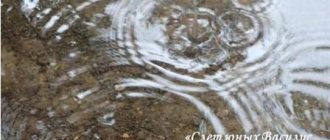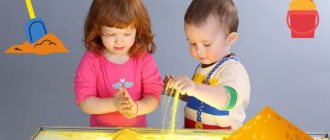Why is sand painting on a light table becoming so popular all over the world?
Currently, the need for new, non-standard ways of thinking has become increasingly felt in the world. The ability to find unexpected solutions and accept any situation as an opportunity to solve an interesting problem is becoming increasingly valuable. Companies spare no expense on training their employees; they conduct trainings to teach people to think creatively. But, unfortunately, teaching adults this ability is quite a difficult task.
No one doubts that the development of creative potential should begin from a very early age, when the child is just beginning to discover the world around him. Thus, one of the most important tasks for teachers, psychologists and parents at the present stage is an individual approach to the development of a child’s creative potential. In solving this urgent problem, the course “Art Therapy: Drawing on the Sand” can help you.
Explanatory note
Drawing with sand is a new and at the same time simple type of visual activity for preschoolers, accessible to almost everyone and not requiring special training. And for the teacher, this is another way to understand the child’s feelings.
The concept of preschool education provides for the development of the child’s personality, taking into account his individual characteristics in the physical, mental and emotional spheres. According to the new federal state requirements for the structure of the basic general education program of preschool education, approved by order of the Ministry of Education and Science of Russia dated November 23, 2009 No. 655, the emphasis is not on knowledge, skills and abilities, but on the formation of the general culture of the preschooler.
To teach children the technique of sand painting, the developments of the following authors are used: T.V. Akhutina, Z.M. Boguslavskaya, O.I. Bochkareva, N.N. Vasilyeva, A. Viktorova, N.K. Vinokurova, R.R. Kalinina, T.S. Komarova, K.V. Tarasova.
This type of drawing is one of the most unusual ways of creative activity, as children create unique masterpieces with their own hands in the sand. In an amazing way, a handful of sand turns into a landscape, starry sky, forest or sea. This unusual type of art is called Sand art, i.e. “sand art”. Sand is the same paint, but it works on the principle of “light and shadow” and perfectly conveys human feelings, thoughts and aspirations. Sand drawing is one of the most important means of understanding the world and developing aesthetic perception, since it is closely related to independent and creative activity. This is one of the ways to depict the world around us. As the child masters the sand painting technique, the child’s inner world is enriched and developed. This type of creativity as a means of mental correction allows the little artist to overcome the feeling of fear, moving away from objective representation and depiction with traditional materials, to express feelings and emotions in the drawing, gives freedom, and instills confidence in their abilities. Having mastered the technique of drawing with sand, the child gets the opportunity to choose, which, in turn, ensures the creative nature of children's productive activities.
Taking this into account, the MBDOU created the “Loose Pictures” artistic and aesthetic development program, which is aimed at teaching children in the preparatory group the technique of sand painting.
The objectives of this training program are:
- stimulating children's independence and creativity in visual arts using sand painting techniques;
- harmonization of the psycho-emotional state of preschool children;
- development of hand-eye coordination;
- fluent use of both hands.
In accordance with the goals, the following tasks are solved in the process of teaching children sand drawing techniques:
- developing the ability to convey the shape, structure of an object and its parts, the correct proportions of parts, using different shades of light and shadow;
- learning to create static sand paintings taking into account rhythm and symmetry;
- development of compositional skills when depicting groups of objects or a plot;
- exercise of fingers and hands;
- development of artistic and aesthetic taste.
This technique is taught as part of the entire drawing course and is based on the following principles:
- the focus of educational activities on the development of the child, and not on imparting to him the amount of knowledge.
- creating a friendly, creative atmosphere so that a preschooler can express his thoughts out loud without fear of criticism.
- The educational process is built using games and play exercises aimed at developing creativity, activity and independence in visual arts.
Conditions for the program:
The program is implemented outside the framework of the main educational activities.
The necessary conditions have been created to teach children the technique of sand painting: classes are held in a separate room - an art studio, which is equipped with individual tablet tables with a glass surface and lighting. For the drawings, river sand is used, pre-sifted, washed and calcined.
Lesson mode.
| Senior group | Preparatory group | |
| Qty | 2 times per week | 2 times per week |
| Duration | 25 min. | 30 min. |
Children's organization form | Class | Class |
Expected Result:
- development of smoothness, grace and precision of movements;
- ability to work with the hand and fingers of both hands;
- hand-eye coordination;
— mastery of technical skills: regulation of the strength of movements, a certain amplitude, speed, rhythm; the ability to change the scope and direction of hand movement when drawing; a harmonious combination of lines, color and shadow.
What impact does sand painting have on children?
Creating drawings in the sand opens up amazing opportunities for teachers, educators, speech therapists, psychologists, as well as parents who want to diversify their child’s leisure time and spend it usefully. Rich in tactile experience, such activities help children better understand the material being studied and significantly improve fine motor skills. They also stimulate the development of speech and spatial thinking.
In addition, a backlit table is an amazing canvas that can change as the little creator creates fancy curlicues or magical paintings. Perhaps no other form of fine art provides so much creative freedom for self-expression.
Sand drawing classes with children using a light table and sand drawing games are an immersion into the world of a fairy tale, into the world of emotions. Drawing with sand on glass has a great influence on the development of children, namely it helps:
develop:
- cognitive processes (perception, attention, memory, figurative and logical thinking, spatial imagination);
- self-regulation processes;
- sensory-perceptual sphere;
- creative potential;
form:
- communication skills;
- positive attitude towards the environment;
train:
- fine motor skills of hands;
harmonize:
- psycho-emotional state.
Sand painting materials
To learn to draw on sand, you need to purchase a list of materials and equipment. All of them are affordable, you won’t have to fork out a lot of money. Here's what the young artist will need:
- table with sides and a lighting device at the bottom;
- sand;
- antistatic agent in a can;
- additional equipment - art brushes, sticks, sieve, templates;
- a wide and flat brush for sweeping grains of sand from the corners of the table.
An antistatic agent is necessary to prevent sand grains from sticking together, which is inevitable when quartz material is used repeatedly. The spray should be sprayed before each lesson. A regular antistatic agent is suitable, preventing synthetic clothing from sticking to the body.
You can buy a table or make it yourself. Homemade design - sides connected in a rectangular shape with a bottom made of frosted glass or plastic up to 5 mm thick. It is necessary to fix the lamp from below so that diffused light is obtained. The lighting can be anything: in the warm and cold range, even colored. The legs of the table should not wobble, otherwise when drawing you will not be able to draw neat lines.
The finished table is a structure with sides and a bottom in the form of an illuminated tablet. The optimal format is 130x70 cm, but for a child 70x50 cm is enough. The height of the sides should be at least 6-7 cm, but from the side of the drawer it is only 3 cm, otherwise it will be inconvenient to draw the lower elements. It is necessary to leave indentations for sand 10-15 cm wide on the right and left sides. It is advisable that these areas be in the same plane as the space for drawing, this makes it more convenient to use many techniques. But some ready-made tables have tray recesses on both sides.
Any sand will do. You can buy an aquarium one at a pet store, and a special one for creativity at a supermarket in the children's section. You can contact a children's and adult creativity studio where sand animation is practiced, if there is such an institution in the locality. They probably won't refuse to sell a small amount of sand. The fraction of the material can also be any. It is advisable to get different ones, since fine sand is convenient for creating tones and halftones, and coarse sand is convenient for creating large image details.
If there is a river near your house, you can dig up sand on the shore. You just have to filter it through a fine-mesh sieve, then rinse. The washing procedure looks like this:
- Pour 4-5 kg of sand into a bucket. This is the standard amount for drawing.
- Fill with water to the edge of the bucket.
- Stir gently with your hand or a large spoon.
- When dust and dirt particles rise to the surface and heavier grains of sand settle to the bottom, carefully drain the water.
- Repeat the procedure until the drained water becomes crystal clear.
- Dry the cleaned material on the balcony if the weather is sunny, or on a radiator, or in the oven.
You can replace sand with semolina, finely ground salt, and to create darker and more contrasting elements of the image - ground coffee.
Bulk material should be renewed once every 3 months, and if the child draws every day, then once every 1.5 months. If this is not done, the sand will become less pliable, since with constant friction the grains of sand are destroyed and the structure of the material softens.
What is needed for sand painting classes with children on a light table?
To practice drawing with sand on a light table with children, you will need:
1. Light table with impact-resistant glass on legs with small sides and with or without a compartment. A compartment may be needed for auxiliary materials. The size of the table directly depends on the age of the children you will be teaching. We recommend the following light table sizes:
- 2.0 - 3.5 years: 24cm x 50cm
- 4.0 – 10 years: 50cm x 65cm
- Over 10 years: 60cm x 80cm
2. LED lighting with a control panel, with which you can choose any lighting for your sand painting.
3. Pure quartz sand . To obtain beautiful stains that form a pattern, only fine sand is needed. Any inclusion of larger grains of sand can spoil the result of creativity. To create a greater effect of sand paintings, you can use colored sand.
Program passport
| Program name | Working curriculum for teaching sand drawing to children of senior preschool age “Loose pictures” |
| Contingent | Preschool children |
| Legal basis of the program | Convention on the Rights of the Child, laws of the Russian Federation and the Komi Republic “On Education”, Charter of the preschool educational institution. |
| Program developers | Teacher of the first category - Lvova M.V. |
| Main performers | Teacher of the first category - Lvova M.V. |
| Purpose of the program |
|
| Implementation deadlines | |
| Tasks |
|
Sand painting courses for teachers
In order to use any innovation in the field of child development, you must first become familiar with it yourself. Courses with sand will allow you to master a new tool, thanks to which the children will be able to practice more effectively. You can learn how to use this technique online. Thanks to Internet technologies, students study in Moscow without attending face-to-face classes. This is extremely convenient, because you can study at any convenient Internet access point: in a cafe with a laptop, with a tablet in a sunny park, or at a desktop computer at home.
After completing distance learning courses for teachers, the graduate will receive a certificate of completion of the CPC, as well as the knowledge and skills necessary for further work. Experts are pleased to note the extraordinary ability of this type of creativity to calm, give a feeling of security, and at the same time allow you to express the most vivid emotions. We invite you to master and successfully use this wonderful technique in your work.
Educational and thematic plan
1 year of study.
| № | Tasks | Number of hours | Subjects of classes |
| Cycle “Great lines, interesting figures” | |||
| 1 | Introduce children to sand painting techniques. | 4 | “The magic of lines. Sand painting” |
| 2 | Teach children to draw curls with their fingers. | 4 | "Frost patterns. Patterns on glass" |
| Cycle “Story Drawing” | |||
| 1 | Learn to create images to music, develop creative imagination | 4 | "Music of the Forest" |
| 2 | Learn to draw with your fingers synchronously, develop your imagination | 3 | "Fairytale Birds" |
| 3 | Learn to draw with the back of your hand | 3 | "Winter forest" |
| 4 | Strengthen the skill of drawing curls | 4 | “Flowers are also different” (as planned) |
| 5 | Encourage creative ideas and solutions | 3 | "The Singing Silence of the Deep Sea" |
| 6 | Teach the technique of pinching and pouring sand | 3 | "Fun Zoo" |
| 7 | Develop imagination, consolidate familiar techniques | 2 | “Two Umbrellas of Ole Lukoje” (as planned) |
| 8 | Learn to creatively express your idea, consolidate drawing methods | 3 | "Fairy-tale heroes" |
| 9 | Develop a sense of composition, a sense of texture | 3 | "Rainbow over the city" |
| 10 | Develop the ability to convey the shape and size of objects | 4 | "City of Dreams" (as planned) |
| 11 | Develop tactile sensitivity and finger motor skills | 4 | "On Another Planet" |
| 12 | Develop compositional skills when depicting groups of objects | 4 | "A colorful fairy tale" |
| 13 | Consolidation of familiar drawing techniques, development of imagination | 4 | “Beauty is nearby” (as planned) |
| 14 | Strengthen the ability to perform movements synchronously | 3 | "Seaweed" |
| 15 | Strengthen technical skills and abilities | 3 | "Summer rain. Hurricane" |
| 16 | Learn to express your emotions in drawing through the perception of music | 2 | "Sounds of nature" |
| 17 | Develop creative independence through sand painting techniques | 2 | "In the land of elves" |
| 18 | To cultivate artistic taste in the knowledge of beauty | 2 | "Spring Fantasies" |
| Total: 64 hours | |||
2nd year of study.
| № p/p | Number of hours | Subjects of classes |
| 1 | 3 | Magic lines |
| 2 | 2 | Swans |
| 3 | 2 | Rainbow over the city |
| 1 | 1 | Orchard |
| 2 | 1 | Seascape |
| 3 | 2 | Still life |
| 4 | 2 | In the animal world |
| 5 | 2 | Fairytale birds (by design) |
| 6 | 2 | Christmas tree |
| 7 | 2 | Winter landscape |
| 8 | 2 | New Year |
| 9 | 2 | Frosty patterns on glass |
| 10 | 2 | City of Dreams (by design) |
| 11 | 2 | Winter forest |
| 12 | 2 | Seascape |
| 13 | 2 | Portrait |
| 14 | 2 | The beautiful is nearby (by design) |
| 15 | 1 | Flowers for mom |
| 16 | 2 | Spring drops |
| 17 | 3 | A colorful fairy tale |
| 18 | 2 | Desert Island |
| 19 | 2 | Planet Earth |
| 20 | 3 | Secrets of space |
| 21 | 2 | Summer rain, hurricane |
| 22 | 2 | City street |
| Total: 60 hours | ||






